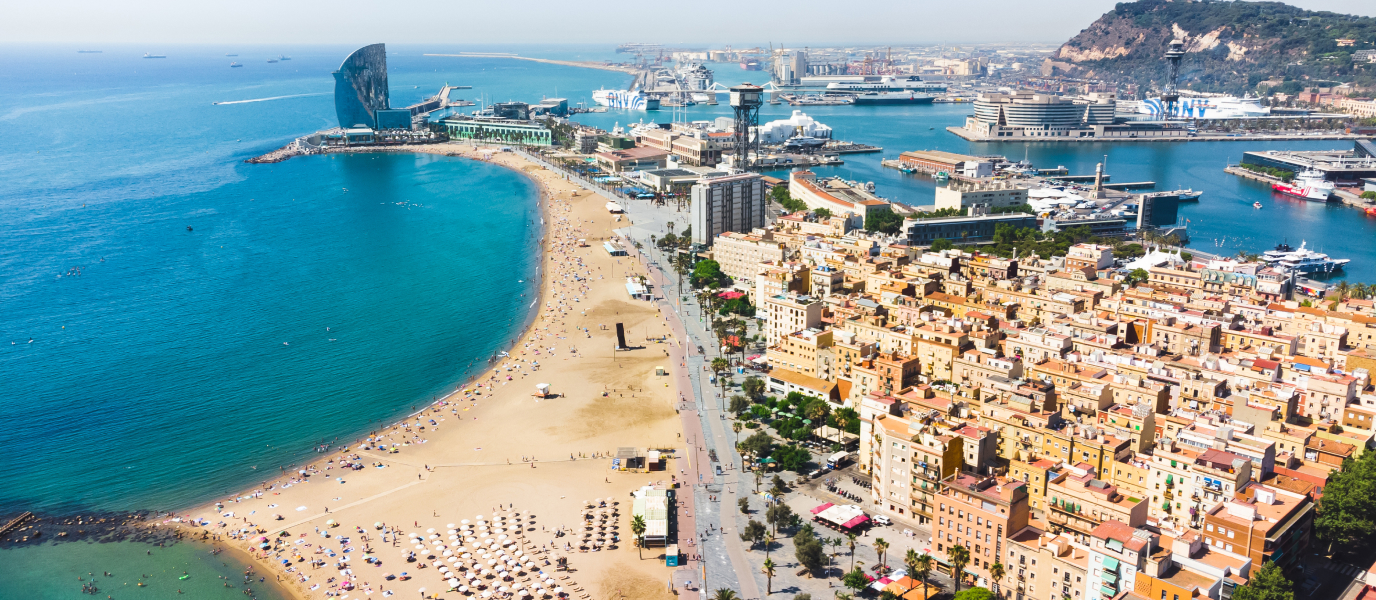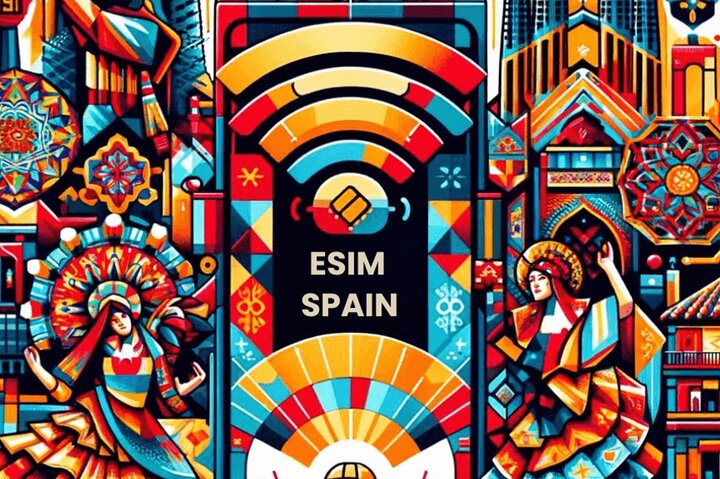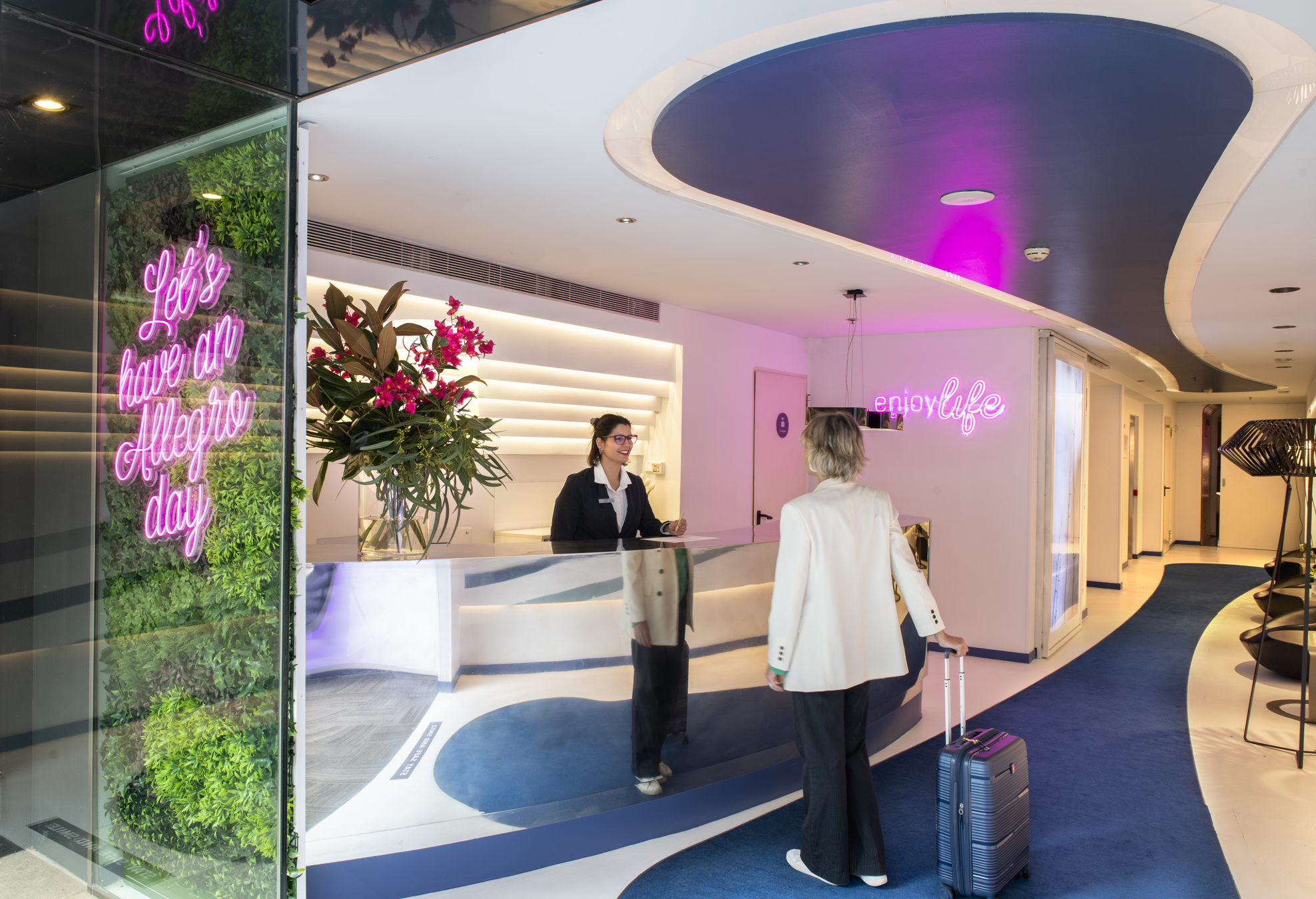Barcelona gave its waterfront a complete facelift in preparation for the 1992 Olympic Games. The city opened itself to the sea by creating new areas for leisure and swimming, giving new life to certain spots that had been neglected until then. Sculptures and monuments with Olympic themes were installed along the beachfront promenade that lines Barcelona’s coast from north to south.
The city currently has 4.5 kilometres of urban beaches that represent Barcelona’s largest leisure areas, along with a waterfront promenade and bike lane along the entire coast.
The Beach Centre, a place for environmental awareness
In 2006, the Barcelona City Council built an information centre on the coast. Located on Playa Somorrostro, facing Hospital del Mar, it features games, shows, workshops, itineraries and exhibitions about the sea and coast. It also has a free rental service for beach games, newspapers, books and sports equipment. This service is available from March to September.
The centre also arranges guided tours of the surrounding area, including the seawall, the fish market, the zoo and the Barceloneta district. These family-friendly activities are free, but space is limited so spots are made available by order of arrival.
A mobile beach-library will depart from this location and visit Barcelona’s beaches to offer educational activities about marine biodiversity.
Sant Sebastià Beach, the sportiest
This beach on the southernmost end of the city is where we will begin, as we make our way northward. This area is home to Barcelona’s oldest beaches. Sant Sebastià has a number of clubs for water sports. A sculpture made by Alfredo Lanz that pays tribute to swimming is on display at this beach. The bronze figures represent various water sports events: diving, synchronised swimming, water polo and crawl.
There is another sculpture near this beach, a creation by Juan Muñoz for the Olympic Games. It consists of a room where it always rains, formed by a cage with five bronze figures inside, surrounded by trees that offer shade. This is a landmark that invites visitors to reflect.
The beach is approximately 660 metres long and is popular with older crowds.
The Torre de Sant Sebastià tower is adjacent to this beach, in the port area. From here, you can take the cable car to Montjuïc (internal link).
How to arrive
- Bus: Routes 14, 16, 17, 39, 40, 45, 51, 57, 59, 64 and 157.
- Metro: Barceloneta, line 4.
Sant Miquel Beach, the liveliest
This beach is named after the nearby Church of Sant Miquel del Port. Built in 1755, it now has a bustling atmosphere, despite its small size. It is popular with young people and tourists because it is easy to reach using public transportation. This beach is also frequented by nudists. The Ecobeach flag flies proudly over this beach as a sign of its quality and services.
How to arrive
- Bus: Routes 10, 14, 16, 17, 36, 39, 40, 45, 51, 57, 59 and 64.
- Metro: Barcelonetaand Ciutadella, line 4.
- Tram: Ciutadella-Vila Olímpica
Barceloneta Beach, the most popular
Barceloneta Beach, one of the city’s largest and most famous beaches, is visited by foreigners and young people who enjoy its sports facilities. There are beach volleyball courts, ping pong tables, an exercise area, playgrounds and a beach-library service. Located between the Gas breakwater and Sant Miquel Beach, Barceloneta is 422 metres long. At this beach, visitors will come across a structure with cubes made of iron and glass, twisted and stacked seemingly at random. This sculpture by the German artist Rebecca Horn is called ‘La estrella herida’, although locals refer to it as ‘the cubes’. It represents a wounded star that has fallen from the sky.
How to arrive
- Bus: Routes 14, 16, 17, 36, 39, 40, 45, 51, 57, 59 and 64.
- Metro: Barcelonetaand Ciutadella, line 4.
- Tram: Ciutadella-Vila Olímpica.
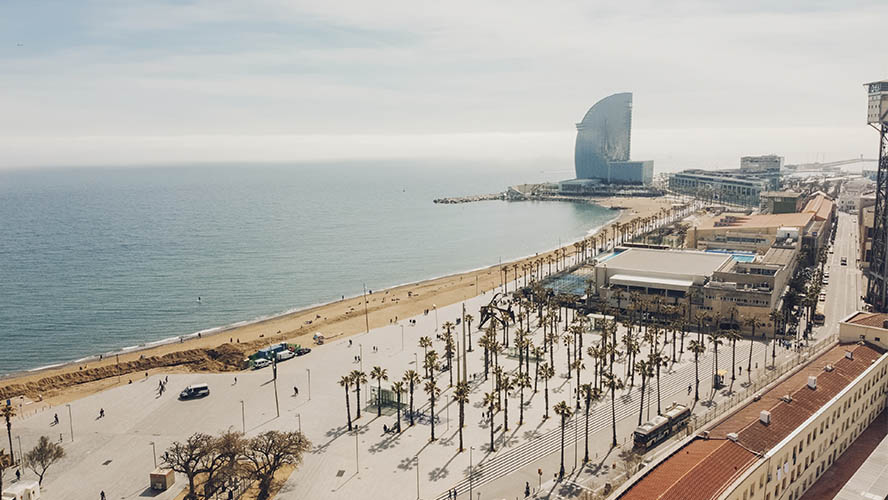
Somorrostro Beach, for younger crowds
This small stretch of beach previously formed part of Barceloneta Beach, but it was recently renamed as a tribute to the slum that stood here for 100 years until it was torn down by Franco in 1966. Located between the Gas breakwater and the Marina pier, it is a favourite with younger crowds because it is easy to reach using public transportation.
The Olympic Port near the beach is home to one of the most famous sculptures built for the 1992 Olympic Games. ‘El Peix’ (The Fish) by the architect Frank Gehry has become one of the city’s symbols. With its large size and metal structure, the scales shine bright under the sunlight, particularly at sunrise.
How to arrive
- Bus: Routes 14, 16, 17, 36, 39, 40, 45, 51, 57, 59 and 64.
- Metro: Barcelonetaand Ciutadella, line 4.
- Tram: Ciutadella-Vila Olímpica.
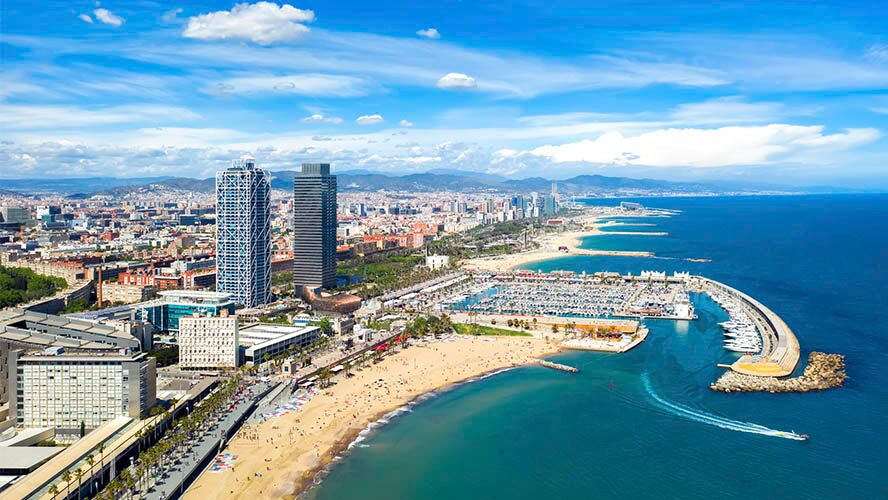
Nova Icària Beach, the most family oriented
This peaceful beach is popular with families with kids. It has sports facilities such as beach volleyball courts, a playground and a ping pong table. Due to its calm and peaceful atmosphere, people spend the most time at this beach that spans 415 metres in length.
The surrounding area is home to several sculptures that were installed for the Olympic Games. Across from the beach, in Les Cascades Park, there is an avant-garde sculpture by Antoni Llena called David and Goliath, consisting of a steel mask held up by three legs. At the same location, next to the pond, there is also an installation by Auke de Vries called ‘El poder de la palabra’ (The Power of Words). This abstract work by the Dutch artist was gifted to Barcelona shortly before the Olympic Games.
How to arrive
- Bus: Routes 6, 36, 41, 92 and 141.
- Metro: Ciutadella and Bogatell, line 4.
- Tram: Ciutadella-Vila Olímpica.
Bogatell Beach, a peaceful atmosphere for older crowds
This beach was one of the ones created in the late twentieth century, when the city’s waterfront was redeveloped. It is usually visited by older crowds.
Along its 702-metre length, there are two ping pong tables, a beach football field and beach volleyball courts.
How to arrive:
- Bus: Routes 6, 36, 41, 92 and 141.
- Metro: Poblenou and Llacuna, line 4.
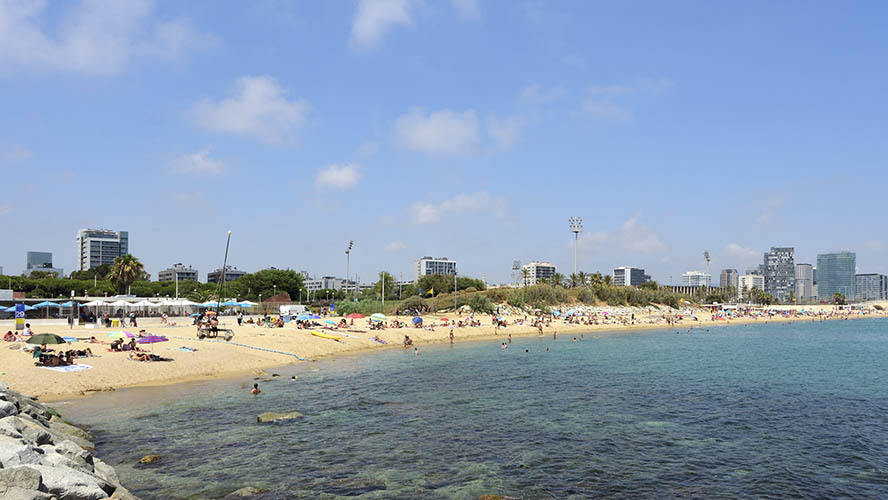
Mar Bella Beach, nudist area included
This beach was created during the urban redevelopment for the 1992 Olympic Games. It is 512 metres long and is popular with younger crowds, primarily from the Sant Martí district, and there is also an area for nudists. There is a nautical facility for water sports as well as leisure alternatives. The area near the Bac de Roda breakwater has beach volleyball courts and a playground. There is also a basketball hoop, skatepark and ping pong tables on the promenade overlooking the beach.
How to arrive
- Bus: Routes 36, 71 and 141.
- Metro: Selva de Mar, line 4.
- Tram: Selva de Mar.
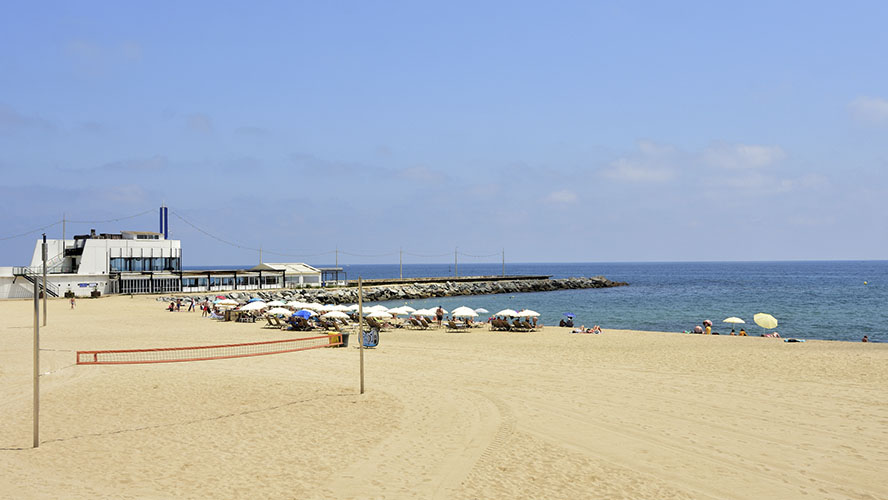
Nova Mar Bella Beach, women’s favourite
This is known as the women’s beach and it was also created during Barcelona’s waterfront redevelopment project for the Olympic Games. It has a peaceful atmosphere and is popular with young people, particularly women. It has beach volleyball courts and also boasts the Ecobeach flag for its quality and services.
How to arrive
- Bus: Routes 36, 43 and 141.
- Metro: Selva de Mar and El Maresme, line 4.
- Tram: Selva de Mar and El Maresme.
Levant Beach, the official dog beach
As the last beach added to the Barcelona waterfront, it is the only one for dogs. It was refurbished in 2006 following the removal of the Prim breakwater and the construction of a platform to house the marine zoo.
Since it is further from the city centre, it has a more relaxed atmosphere and fewer people. In the summer, a 1,250 metre area is physically separated from the beach, with space for up to 100 dogs and their owners.
It also has beach volleyball courts.
How to arrive
- Bus: Routes 7, 36, 41 and 141.
- Metro: Selva de Mar, line 4.
- Tram: Selva de Mar and El Maresme.
Fòrum swimming area, a paradise for cyclists
Although this is not exactly a beach, it was created for swimming in the sea and there are steps leading to the water from the paved area. In reality, it is a saltwater pool within the sea, minus the inconvenient sand that many people dislike. This area has become a favourite for cyclists, who like to cool off here thanks to its proximity to the bike lane.
How to arrive
- Bus: Routes 7, 143 and h16.
- Metro: El Maresme, Fòrum, line 4.
- Tram: Fòrum.







































































